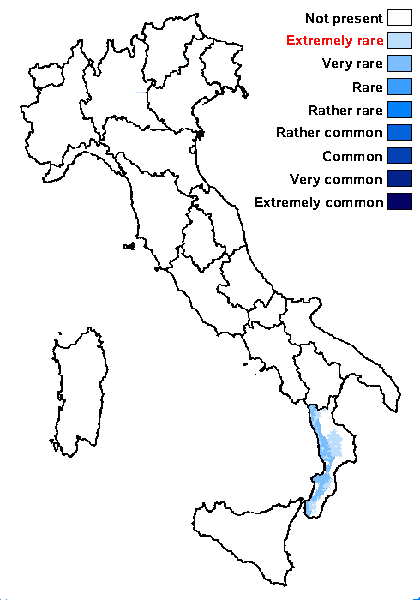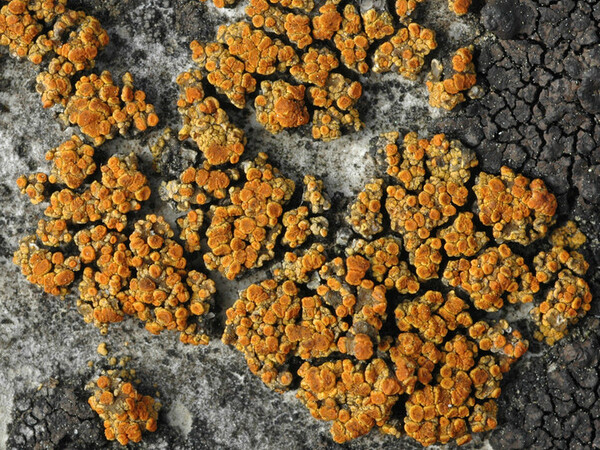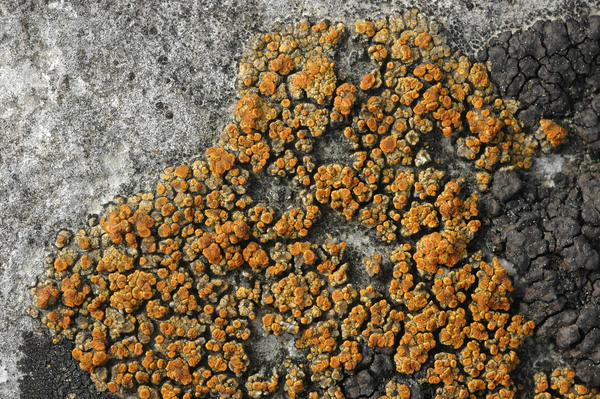Variospora glomerata (Arup) Arup, Søchting & Frödén
Nord. J. Bot., 31: 75, 2013. Basionym: Caloplaca glomerata Arup - Ann. Bot. Fenn., 27: 329, 1990.
Synonyms:
Distribution: S - Cal (Puntillo 1996).
Description: Thallus crustose, episubstratic, yellow-orange, epruinose, consisting of adjacent, usually flat or slightly convex, angular to irregular, 0.2-1 mm wide areoles, forming 1-3 cm wide patches, without a distinct prothallus. Apothecia usually abundant and characteristically crowded, zeorine, immersed in the areoles to finally subsessile, round to irregular in outline, 0.35-0.7(-1) mm across, with a reddish-orange, flat to slightly convex, epruinose disc, and a slightly paler, smooth, persistent but finally very thin margin. Thalline exciple, when developed, c. 50 µm wide; proper exciple 50-100 µm wide; epithecium orange, K+ red; hymenium colourless, (60-)70-90 μm high; paraphyses simple or sparingly branched, 1-2.5 μm thick at base, the apical cells up to 4(-5) μm wide; hypothecium colourless, with up to 7 µm large oil droplets. hyaline, very variable, Ascospores 2-celled, polarilocular, hyaline, ellipsoid to slightly rhomboid, with apically thickened walls, often swollen in the middle, (12-)14-18.5(-20) x (6-)7.5-11.5(-13) μm, the equatorial thickening (“septum”) 3-5 μm, the lumina concave, more or less heart-shaped. Pycnidia orange, immersed. Conidia bacilliform. Photobiont chlorococcoid. Spot tests: thallus and apothecia K+ red, C-, KC-, P-. Chemistry: thallus and apothecia with parietin (major), fallacinal, emodin, teloschistin and parietinic acid (minor), corresponding with chemosyndrome A of Søchting (1997).Note: a mainly Mediterranean species with an areolate, usually richly fertile thallus bearing several crowded apothecia per areole, and ascospores with lumina recalling the Mischoblastia-type, found on limestone in Circinaria calcarea communities, often invading thalli of various species of the Pyrenodesmia variabilis-group; probably more widespread in Southern Italy, but overlooked, or confused with other species.
Growth form: Crustose
Substrata: rocks
Photobiont: green algae other than Trentepohlia
Reproductive strategy: mainly sexual
Commonnes-rarity: (info)
Alpine belt: absent
Subalpine belt: absent
Oromediterranean belt: absent
Montane belt: extremely rare
Submediterranean belt: absent
Padanian area: absent
Humid submediterranean belt: very rare
Humid mediterranean belt: absent
Dry mediterranean belt: absent

Predictive model
Growth form: Crustose
Substrata: rocks
Photobiont: green algae other than Trentepohlia
Reproductive strategy: mainly sexual
Commonnes-rarity: (info)
Alpine belt: absent
Subalpine belt: absent
Oromediterranean belt: absent
Montane belt: extremely rare
Submediterranean belt: absent
Padanian area: absent
Humid submediterranean belt: very rare
Humid mediterranean belt: absent
Dry mediterranean belt: absent

Predictive model
 Index Fungorum
Index Fungorum
 GBIF
GBIF




